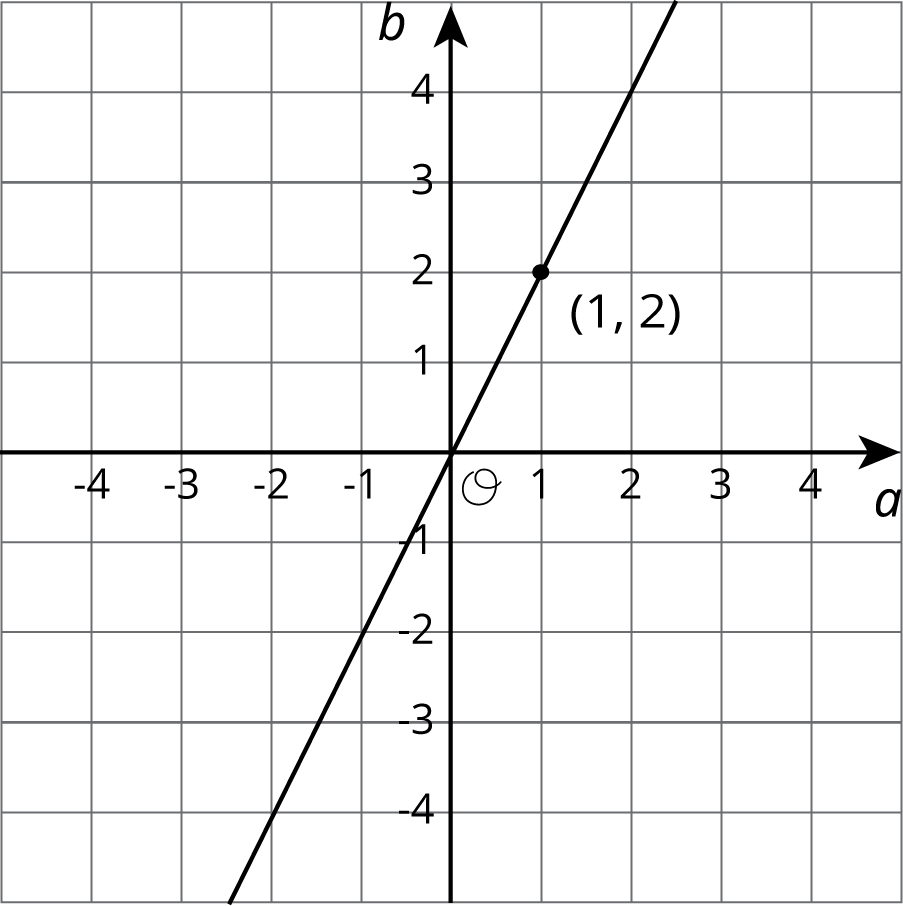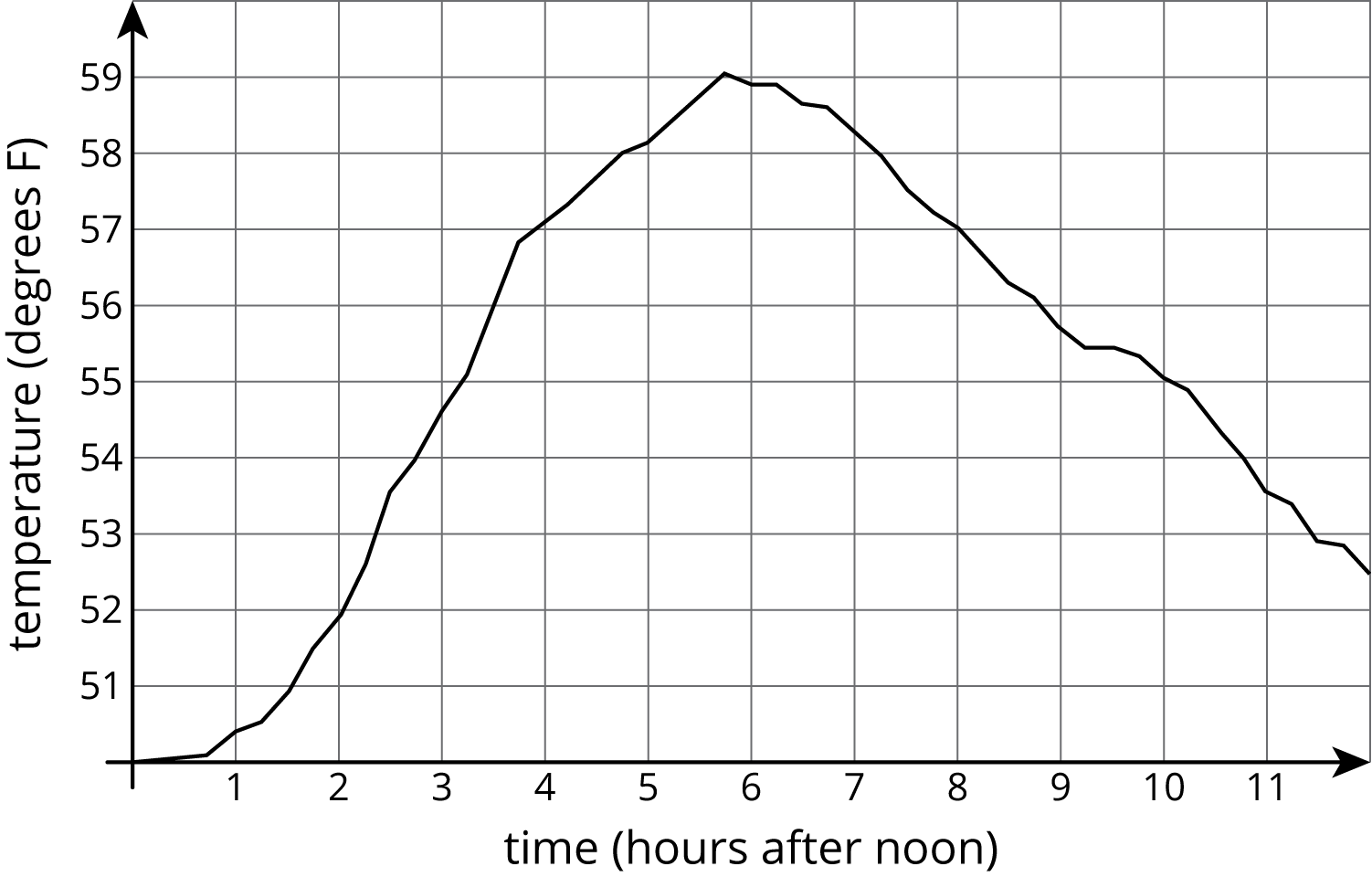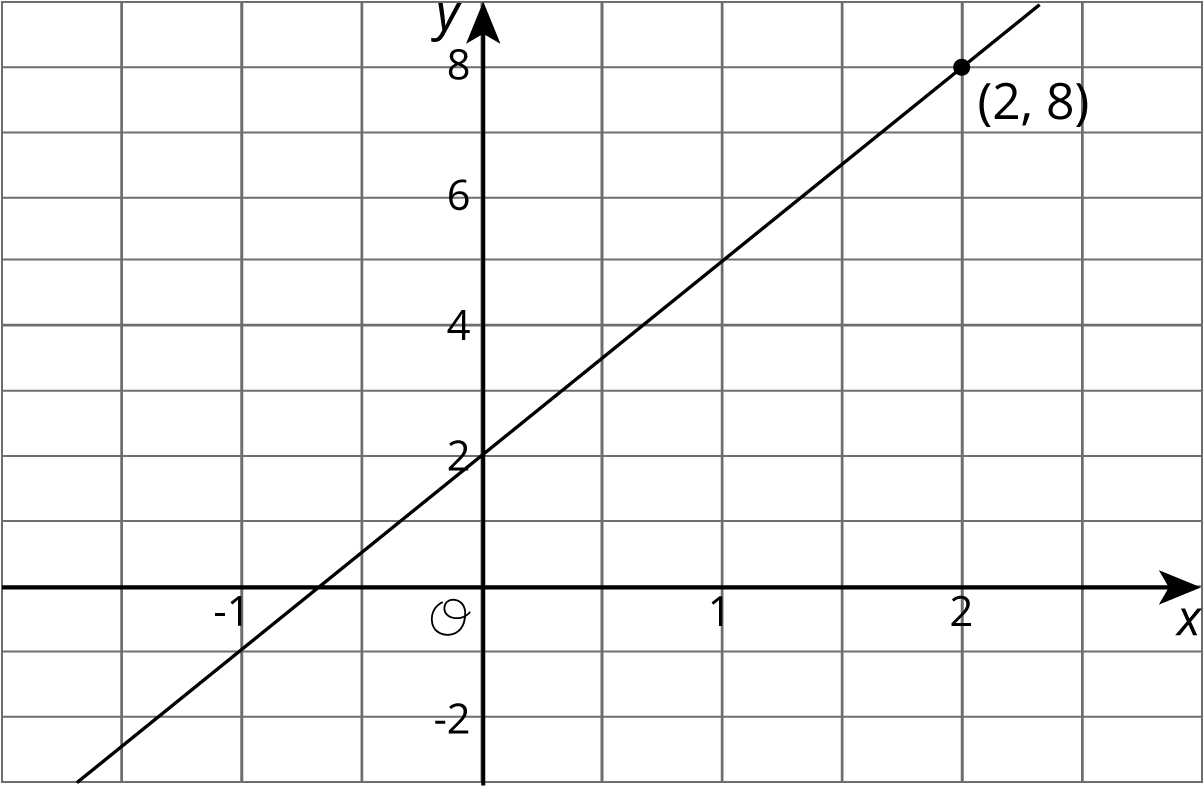Lesson 7
Connecting Representations of Functions
7.1: Which are the Same? Which are Different? (5 minutes)
Warm-up
The purpose of this warm-up is for students to identify connections between three different representations of functions: equation, graph, and table. Two of the functions displayed are the same but with different variable names. It is important for students to focus on comparing input-output pairs when deciding how two functions are the same or different.
Launch
Give students 1–2 minutes of quiet work time followed by a whole-class discussion.
Student Facing
Here are three different ways of representing functions. How are they alike? How are they different?
\(\displaystyle y = 2x\)

| \(p\) | -2 | -1 | 0 | 1 | 2 | 3 |
|---|---|---|---|---|---|---|
| \(q\) | 4 | 2 | 0 | -2 | -4 | -6 |
Student Response
For access, consult one of our IM Certified Partners.
Activity Synthesis
Ask students to share ways the representations are alike and different. Record and display the responses for all to see. To help students clarify their thinking, ask students to reference the equation, graph, or table when appropriate. If the relationship between the inputs and outputs in each representation does not arise, ask students what they notice about that relationship in each representation.
7.2: Comparing Temperatures (10 minutes)
Activity
This is the first of three activities where students make connections between different functions represented in different ways. In this activity, students are given a graph and a table of temperatures from two different cities and are asked to make sense of the representations in order to answer questions about the context.
Launch
Arrange students in groups of 2. Give students 3–5 minutes of quiet work time and then time to share responses with their partner. Follow with a whole-class discussion.
Supports accessibility for: Visual-spatial processing
Design Principle(s): Maximize meta-awareness; Support sense-making
Student Facing
The graph shows the temperature between noon and midnight in City A on a certain day.

The table shows the temperature, \(T\), in degrees Fahrenheit, for \(h\) hours after noon, in City B.
| \(h\) | 1 | 2 | 3 | 4 | 5 | 6 |
|---|---|---|---|---|---|---|
| \(T\) | 82 | 78 | 75 | 62 | 58 | 59 |
- Which city was warmer at 4:00 p.m.?
- Which city had a bigger change in temperature between 1:00 p.m. and 5:00 p.m.?
- How much greater was the highest recorded temperature in City B than the highest recorded temperature in City A during this time?
- Compare the outputs of the functions when the input is 3.
Student Response
For access, consult one of our IM Certified Partners.
Activity Synthesis
Display the graph and table for all to see. Select groups to share how they used the two different representations to get their answers for each question. To further student thinking about the advantages and disadvantages of each representation, ask:
- “Which representation do you think is better for identifying the highest recorded temperature in a city?” (The graph, since I just have to find the highest part. In the table I have to read all the values in order to find the highest temperature.)
- “Which representation do you think is quicker for figuring out the change in temperature between 1:00 p.m. and 5:00 p.m.?” (The table was quicker since the numbers are given and I only have to subtract. In the graph I had to figure out the temperature values for both times before I could subtract.)
7.3: Comparing Volumes (10 minutes)
Activity
This is the second of three activities where students make connections between different functions represented in different ways. In this activity, students are given an equation and a graph of the volumes of two different objects. Students then compare inputs and outputs of both functions and what those values mean in the context of the shapes.
Launch
Arrange students in groups of 2. Give students 3–5 minutes of quiet work time and then time to share their responses with their partner. Follow with a whole-class discussion.
If using the digital activity, students will have an interactive version of the graph that the print statement uses. Using this version, students can click on the graph to determine coordinates, which might be helpful. The focus of the discussion should remain on how and why students used the graph and equation.
Supports accessibility for: Conceptual processing
Student Facing
The volume, \(V\), of a cube with edge length \(s\) cm is given by the equation \(V = s^3\). The volume of a sphere is a function of its radius (in centimeters), and the graph of this relationship is shown here.
-
Is the volume of a cube with edge length \(s=3\) greater or less than the volume of a sphere with radius 3?
-
If a sphere has the same volume as a cube with edge length 5, estimate the radius of the sphere.
-
Compare the outputs of the two volume functions when the inputs are 2.
Here is an applet to use if you choose.
Student Response
For access, consult one of our IM Certified Partners.
Launch
Arrange students in groups of 2. Give students 3–5 minutes of quiet work time and then time to share their responses with their partner. Follow with a whole-class discussion.
If using the digital activity, students will have an interactive version of the graph that the print statement uses. Using this version, students can click on the graph to determine coordinates, which might be helpful. The focus of the discussion should remain on how and why students used the graph and equation.
Supports accessibility for: Conceptual processing
Student Facing
The volume, \(V\), of a cube with edge length \(s\) cm is given by the equation \(V = s^3\).
The volume of a sphere is a function of its radius (in centimeters), and the graph of this relationship is shown here.

- Is the volume of a cube with edge length \(s=3\) greater or less than the volume of a sphere with radius 3?
- If a sphere has the same volume as a cube with edge length 5, estimate the radius of the sphere.
- Compare the outputs of the two volume functions when the inputs are 2.
Student Response
For access, consult one of our IM Certified Partners.
Student Facing
Are you ready for more?
Estimate the edge length of a cube that has the same volume as a sphere with radius 2.5.
Student Response
For access, consult one of our IM Certified Partners.
Anticipated Misconceptions
Some students may struggle with the many parts of the second question. These two questions can help scaffold the question for students who need it:
- “What information is given to you and what can you do with it?”
- “What information is the focus of the question and what would you like to know to be able to answer that question.”
Activity Synthesis
The purpose of this discussion is for students to think about how they used the information from the different representations to answer questions around the context.
Display the equation and graph for all to see. Invite groups to share how they used the representations to answer the questions. Consider asking the following questions to have students expand on their answers:
- “How did you use the given representations to find an answer? How did you use the equation? The graph?”
- “For which problems was it nicer to use the equation? The graph? Explain your reasoning.”
Design Principle(s): Support sense-making; Maximize meta-awareness
7.4: It’s Not a Race (10 minutes)
Optional activity
In this activity, students continue their work comparing properties of functions represented in different ways. Students are given a verbal description and a table to compare and decide whose family traveled farther over the same time intervals. The purpose of this activity is for students to continue building their skill interpreting and comparing functions.
Launch
Give students 3–5 minutes of quiet work time, followed with whole-class discussion.
Student Facing
Elena’s family is driving on the freeway at 55 miles per hour.
Andre’s family is driving on the same freeway, but not at a constant speed. The table shows how far Andre's family has traveled, \(d\), in miles, every minute for 10 minutes.
| \(t\) | 1 | 2 | 3 | 4 | 5 | 6 | 7 | 8 | 9 | 10 |
|---|---|---|---|---|---|---|---|---|---|---|
| \(d\) | 0.9 | 1.9 | 3.0 | 4.1 | 5.1 | 6.2 | 6.8 | 7.4 | 8 | 9.1 |
- How many miles per minute is 55 miles per hour?
- Who had traveled farther after 5 minutes? After 10 minutes?
- How long did it take Elena’s family to travel as far as Andre’s family had traveled after 8 minutes?
- For both families, the distance in miles is a function of time in minutes. Compare the outputs of these functions when the input is 3.
Student Response
For access, consult one of our IM Certified Partners.
Anticipated Misconceptions
Students may miss that Elena’s family’s speed has different units than what is needed to compare with Andre’s family. Point out to students that the units are important and possibly ask them to find out how many miles Elena’s family travels in 1 minute rather than 1 hour.
Activity Synthesis
The purpose of this discussion is for students to think about how they use a verbal description and table to answer questions related to the context. Ask students to share their solutions and how they used the equation and graph. Consider asking some of the following questions:
- “How did you use the table to get information? How did you use the verbal description?”
- “What did you prefer about using the description to solve the problem? What did you prefer about using the table to solve the problem?”
Supports accessibility for: Language; Social-emotional skills; Attention
Design Principle(s): Optimize output (for generalization)
Lesson Synthesis
Lesson Synthesis
We looked at several different ways functions are represented today: graphs, tables, equations, and verbal descriptions. We can use each representation to find outputs for different inputs. In each case we may perform different actions, but we are looking for the same information. Consider discussing these questions to emphasize the strengths and weaknesses of the representations with students:
- “Think about each of the representations of a function that we have used today. What is easy or hard about using each representation? What type of question do you prefer to answer with each?”
- “If we had only used tables in the volume activity, how could that have made it easier? Harder?” (It would have been easier to find the volumes when the inputs were the same value, but it would have been harder if the tables didn't have exactly the same inputs.)
- “If we had only used graphs to represent the functions in the car activity, how would that have been easier? How would it have been harder?” (It is easier to compare which is farther at a specific time, but it is harder to have an accurate answer, since graphs require estimation.)
7.5: Cool-down - Comparing Different Areas (5 minutes)
Cool-Down
For access, consult one of our IM Certified Partners.
Student Lesson Summary
Student Facing
Functions are all about getting outputs from inputs. For each way of representing a function—equation, graph, table, or verbal description—we can determine the output for a given input.
Let's say we have a function represented by the equation \(y = 3x +2\) where \(y\) is the dependent variable and \(x\) is the independent variable. If we wanted to find the output that goes with 2, we can input 2 into the equation for \(x\) and finding the corresponding value of \(y\). In this case, when \(x\) is 2, \(y\) is 8 since \(3\boldcdot 2 + 2=8\).
If we had a graph of this function instead, then the coordinates of points on the graph are the input-output pairs. So we would read the \(y\)-coordinate of the point on the graph that corresponds to a value of 2 for \(x\). Looking at the graph of this function here, we can see the point \((2,8)\) on it, so the output is 8 when the input is 2.

A table representing this function shows the input-output pairs directly (although only for select inputs).
| \(x\) | -1 | 0 | 1 | 2 | 3 |
|---|---|---|---|---|---|
| \(y\) | -1 | 2 | 5 | 8 | 11 |
Again, the table shows that if the input is 2, the output is 8.